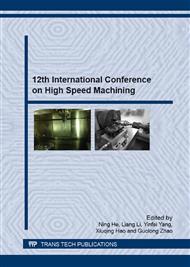[1]
V.P. Astakhov, Metal cutting mechanics. CRC press, (1998).
Google Scholar
[2]
T. Ozel, Numerical modelling of meso-scale finish machining with finite edge radius tools, International Journal of Machining and Machinability of Materials 2. 3 (2007) 451-468.
DOI: 10.1504/ijmmm.2007.015476
Google Scholar
[3]
A. Simoneau, E. Ng, M.A. Elbestawi, Chip formation during microscale cutting of a medium carbon steel, International Journal of Machine Tools and Manufacture 46. 5 (2006) 467-481.
DOI: 10.1016/j.ijmachtools.2005.07.019
Google Scholar
[4]
L. Chuzhoy, R.E. DeVor, S.G. Kapoor, A.J. Beaudoin, D.J. Bammann, Machining simulation of ductile iron and its constituents, part 1: Estimation of material model parameters and their validation, Journal of manufacturing science and engineering 125. 2 (2003).
DOI: 10.1115/imece2001/med-23315
Google Scholar
[5]
L. Chuzhoy, R.E. DeVor, S.G. Kapoor, Machining simulation of ductile iron and its constituents, part 2: numerical simulation and experimental validation of machining, Journal of manufacturing science and engineering 125. 2 (2003) 192-201.
DOI: 10.1115/1.1557295
Google Scholar
[6]
M. Abouridouane, F. Klocke, D. Lung, Microstructure-based 3D Finite Element Model for Micro Drilling Carbon Steels, Procedia CIRP 8 (2013) 94-99.
DOI: 10.1016/j.procir.2013.06.071
Google Scholar
[7]
K. Liu, S.N. Melkote, Finite element analysis of the influence of tool edge radius on size effect in orthogonal micro-cutting process, International Journal of Mechanical Sciences 49. 5 (2007) 650-660.
DOI: 10.1016/j.ijmecsci.2006.09.012
Google Scholar
[8]
J. Larsen-Basse, P.L.B. Oxley, Effect of strain rate sensitivity on scale phenomena in chip formation, Proceedings of 13th International Machine Tool Design and Research Conference, (1973) 209-216.
DOI: 10.1007/978-1-349-01857-4_31
Google Scholar
[9]
K. Liu, S.N. Melkote, Material strengthening mechanisms and their contribution to size effect in micro-cutting, Journal of Manufacturing Science and Engineering 128. 3 (2006) 730-738.
DOI: 10.1115/1.2193548
Google Scholar
[10]
D.J. Waldorf, Shearing, ploughing, and wear in orthogonal machining. University of Illinois at Urbana-Champaign, (1996).
Google Scholar
[11]
G.R. Johnson, W.H. Cook, A constitutive model and data for metals subjected to large strains, high strain rates and high temperatures, Proceedings of the 7th International Symposium on Ballistics 21 (1983) 541-547.
Google Scholar
[12]
M. Abouridouane, F. Klocke, D. Lung, O. Adams, A new 3D multiphase FE model for micro cutting ferritic-pearlitic carbon steels, CIRP Annals-Manufacturing Technology 61. 1 (2012) 71-74.
DOI: 10.1016/j.cirp.2012.03.075
Google Scholar
[13]
Abaqus 6. 11 Documentation, Abaqus/CAE user's manual, (2011).
Google Scholar
[14]
N.N. Zorev, Inter-relationship between shear processes occurring along tool face and shear plane in metal cutting, International Research in Production Engineering 49 (1963).
Google Scholar
[15]
T.H.C. Childs, K. Maekawa, Maekawa, Computer-aided simulation and experimental studies of chip flow and tool wear in the turning of low alloy steels by cemented carbide tools, Wear 139 (1990) 235–250.
DOI: 10.1016/0043-1648(90)90048-f
Google Scholar
[16]
X. Zhang, S. Wu, H. Wang, C.R. Liu, Predicting the effects of cutting parameters and tool geometry on hard turning process using finite element method, Journal of Manufacturing Science and Engineering 133. 4 (2011) 041010.
DOI: 10.1115/1.4004611
Google Scholar
[17]
J. Rech, C. Claudin, E. D'Eramo, Identification of a friction model— Application to the context of dry cutting of an AISI1045 annealed steel with a TiN-coated carbide tool, Tribology International 42. 5 (2009) 738-744.
DOI: 10.1016/j.triboint.2008.10.007
Google Scholar


